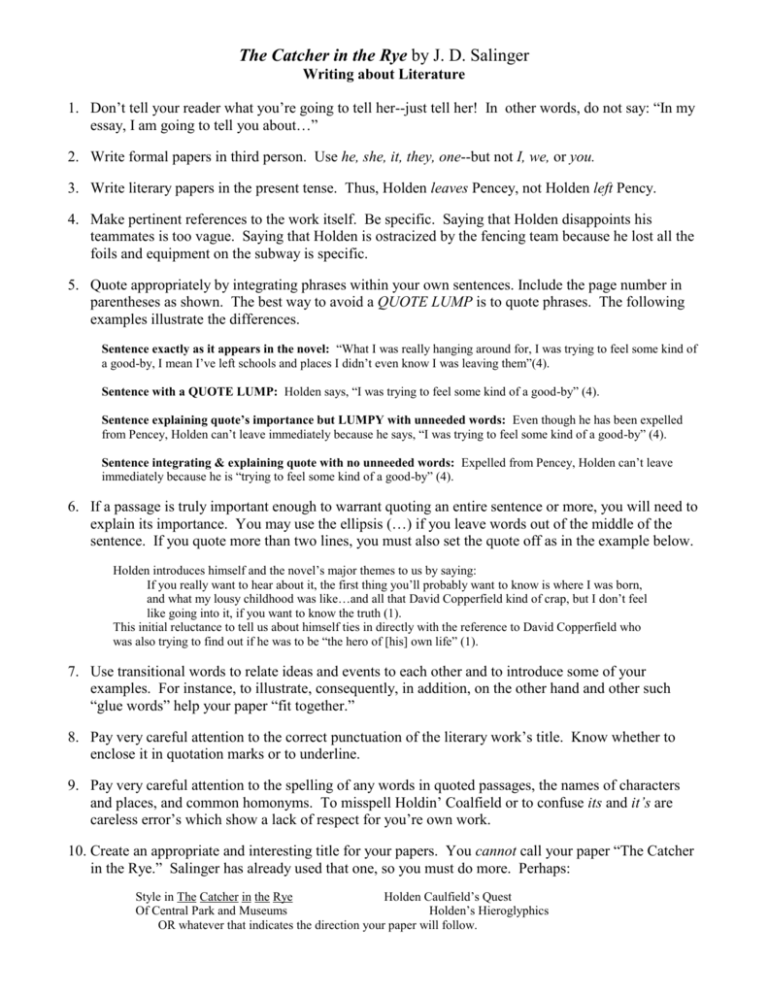CatcherEssay.doc
advertisement

The Catcher in the Rye by J. D. Salinger Writing about Literature 1. Don’t tell your reader what you’re going to tell her--just tell her! In other words, do not say: “In my essay, I am going to tell you about…” 2. Write formal papers in third person. Use he, she, it, they, one--but not I, we, or you. 3. Write literary papers in the present tense. Thus, Holden leaves Pencey, not Holden left Pency. 4. Make pertinent references to the work itself. Be specific. Saying that Holden disappoints his teammates is too vague. Saying that Holden is ostracized by the fencing team because he lost all the foils and equipment on the subway is specific. 5. Quote appropriately by integrating phrases within your own sentences. Include the page number in parentheses as shown. The best way to avoid a QUOTE LUMP is to quote phrases. The following examples illustrate the differences. Sentence exactly as it appears in the novel: “What I was really hanging around for, I was trying to feel some kind of a good-by, I mean I’ve left schools and places I didn’t even know I was leaving them”(4). Sentence with a QUOTE LUMP: Holden says, “I was trying to feel some kind of a good-by” (4). Sentence explaining quote’s importance but LUMPY with unneeded words: Even though he has been expelled from Pencey, Holden can’t leave immediately because he says, “I was trying to feel some kind of a good-by” (4). Sentence integrating & explaining quote with no unneeded words: Expelled from Pencey, Holden can’t leave immediately because he is “trying to feel some kind of a good-by” (4). 6. If a passage is truly important enough to warrant quoting an entire sentence or more, you will need to explain its importance. You may use the ellipsis (…) if you leave words out of the middle of the sentence. If you quote more than two lines, you must also set the quote off as in the example below. Holden introduces himself and the novel’s major themes to us by saying: If you really want to hear about it, the first thing you’ll probably want to know is where I was born, and what my lousy childhood was like…and all that David Copperfield kind of crap, but I don’t feel like going into it, if you want to know the truth (1). This initial reluctance to tell us about himself ties in directly with the reference to David Copperfield who was also trying to find out if he was to be “the hero of [his] own life” (1). 7. Use transitional words to relate ideas and events to each other and to introduce some of your examples. For instance, to illustrate, consequently, in addition, on the other hand and other such “glue words” help your paper “fit together.” 8. Pay very careful attention to the correct punctuation of the literary work’s title. Know whether to enclose it in quotation marks or to underline. 9. Pay very careful attention to the spelling of any words in quoted passages, the names of characters and places, and common homonyms. To misspell Holdin’ Coalfield or to confuse its and it’s are careless error’s which show a lack of respect for you’re own work. 10. Create an appropriate and interesting title for your papers. You cannot call your paper “The Catcher in the Rye.” Salinger has already used that one, so you must do more. Perhaps: Style in The Catcher in the Rye Holden Caulfield’s Quest Of Central Park and Museums Holden’s Hieroglyphics OR whatever that indicates the direction your paper will follow.









